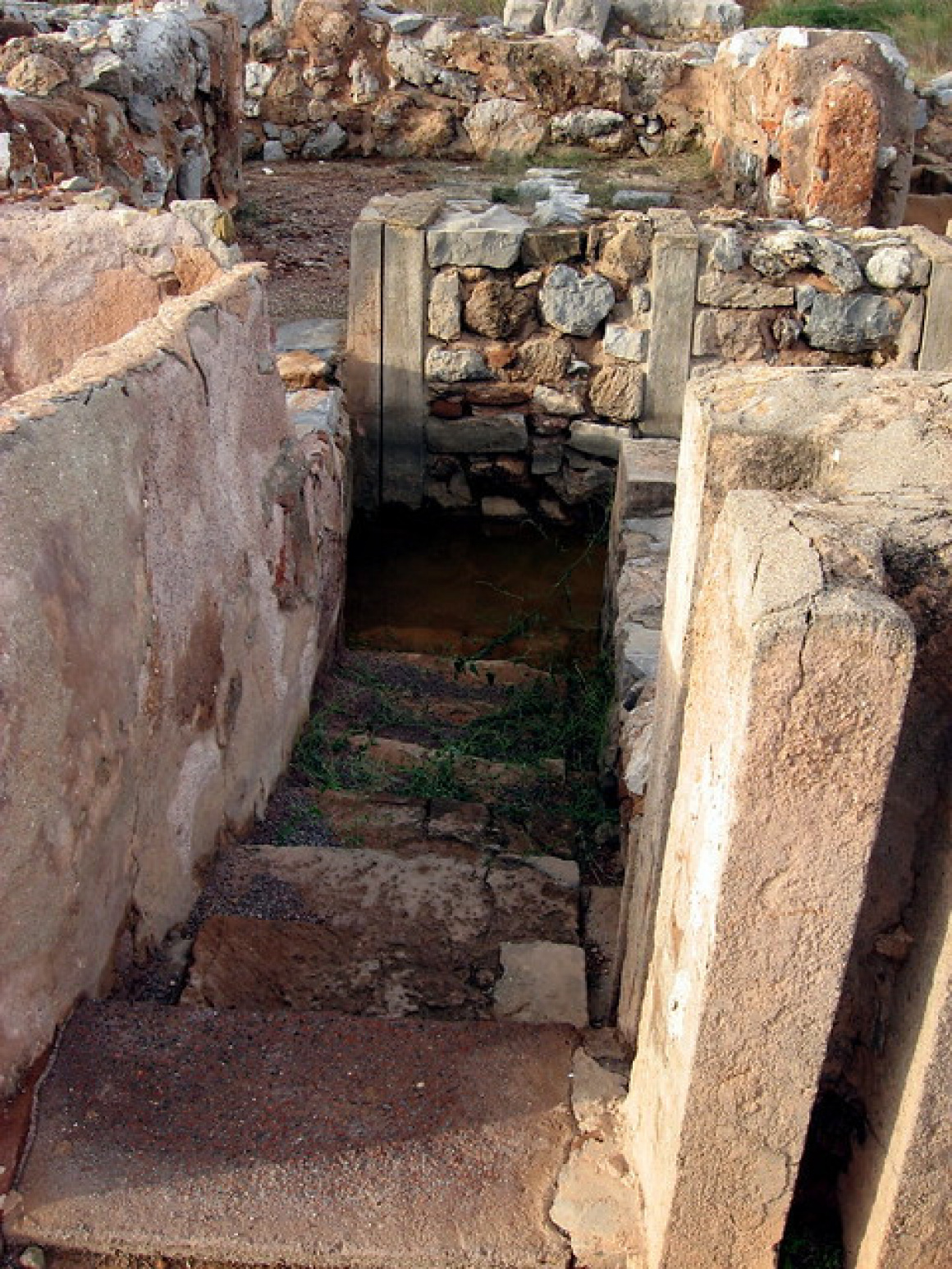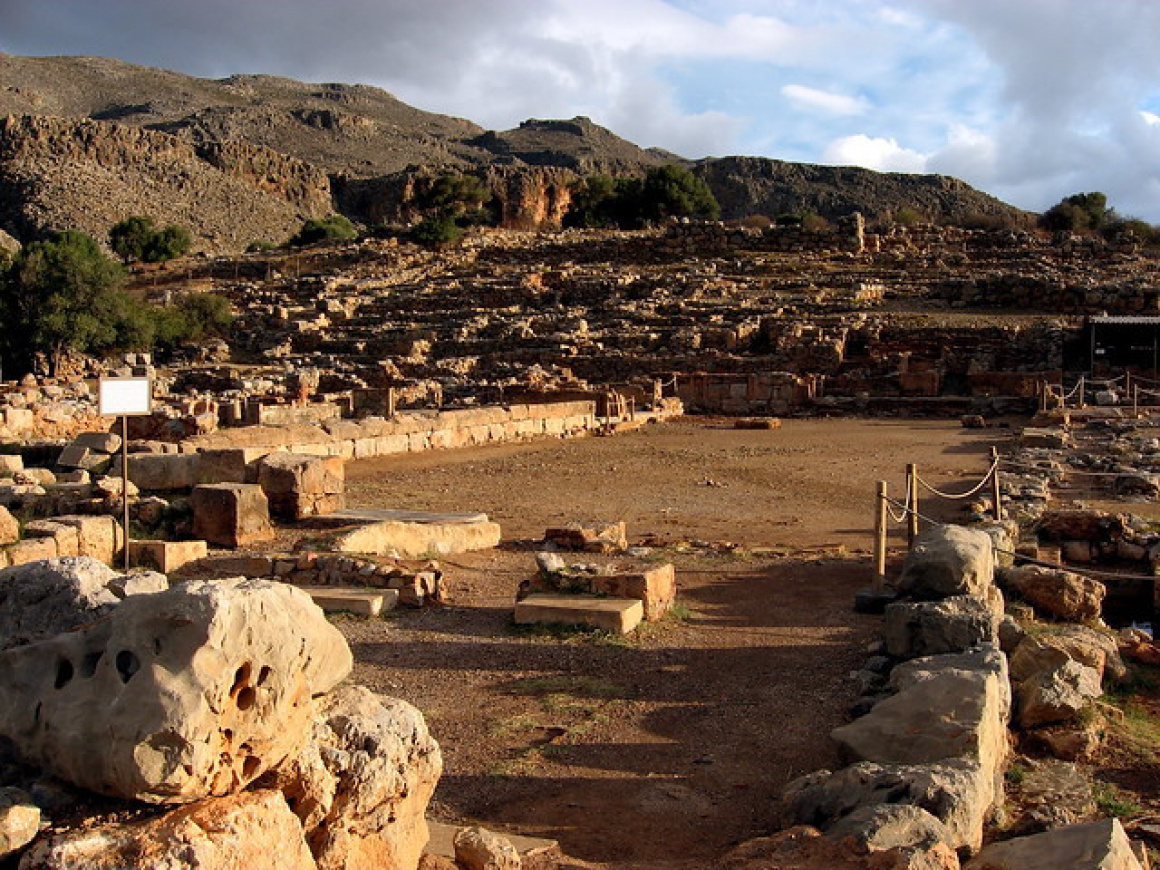Introduction
At the very edge of eastern Crete, where the island tapers into lonely hills and the sea meets the sky in endless blue, lie the ruins of Zakros Palace. Far from the crowds and well-trodden paths, Zakros feels like the final chapter in the story of the Minoan civilization – both literally and figuratively. It was the last of the major Minoan palaces to be discovered by archaeologists, and geographically it's the most remote site, sitting near a sleepy seaside village called Kato Zakros. The setting is sublime: a small valley opens to the sea, and in that valley are the tumbled walls of a Bronze Age palace that once bustled with life. Unlike Knossos Palace or Phaistos Palace, here you might share the site with just a handful of other intrepid explorers and a few bleating goats on the hillside. The atmosphere is one of serene isolation. The sun-baked stones of the palace whisper of ancient traders and artisans, and the surrounding nature – from the dramatic Gorge of the Dead that ends near the palace, to the pebble beach lapped by crystal-clear water – make Zakros a place where history and nature meld beautifully.
A Minoan Gateway to the East
Zakros was one of the four main palatial centers of Minoan Crete (alongside Knossos Palace, Phaistos Palace, and Malia Palace). But in Minoan times, Zakros's location gave it a special role: it was the gateway to the eastern Mediterranean. The palace sits just 100 meters from the sea and was built around 1600 BC (with earlier settlement centuries before). Archaeological finds show that Zakros was a hub of commerce with lands like Egypt, Cyprus, and the Near East.
Excavators unearthed raw materials like copper, ivory, and lapis lazuli here – items that aren't native to Crete. This indicates Zakros was likely a major port where ships from distant civilizations docked, bringing exotic goods and influences.
In fact, one theory is that Zakros may have housed a significant Minoan fleet, protecting trade routes in the Levantine sea. When you stand at the palace site and look out to the bay of Kato Zakros, try to imagine it filled with wooden ships with billowing sails, unloading cargoes of African elephant tusks or Babylonian artifacts. It's clear the Minoans picked this spot not for dominating a hinterland (the area around has limited farmland compared to Knossos or Phaistos), but for its strategic maritime importance.
Mythologically, some connect Zakros with the Keftiu mentioned in Egyptian texts (believed to be Minoans) and see it as part of the inspiration for legends like Atlantis due to its sudden disappearance around 1450 BC.
Discovery and Significance
Zakros Palace remained hidden until the mid-20th century. Local villagers had occasionally found ancient artifacts, but it wasn't until 1961 that Greek archaeologist Nikolaos Platon began systematic excavations and uncovered the palace. What he found stunned the archaeological world: the palace of Zakros was the only Minoan palace discovered in essentially unlooted condition. Unlike Knossos or Malia, which suffered looting in antiquity and heavy disturbance, Zakros's destruction had buried a treasure trove untouched for 3,500 years. It was as if time froze there after whatever cataclysm struck the Minoans around 1450 BC.
The finds from Zakros were astonishing: finely crafted pottery (dozens of ceremonial vases intact), bronze tools, Linear A tablets (the undeciphered script of the Minoans), and intricately carved stone vessels. Two of the most famous were:
These ritual objects, found in a room identified as the Treasury of the Shrine, underscore Zakros's religious importance. Because everything was left as it was, archaeologists could deduce room functions and the final moments of the palace. It appears Zakros's palace was violently destroyed by fire (like the other palaces) and never reoccupied. The fact that so many valuable items were left behind suggests the destruction was sudden, not allowing for salvage – hinting at either an earthquake, invasion, or both.
Exploring the Palace Ruins
The archaeological site of Zakros is well laid-out and tranquil. A path with signage leads through the main areas of the palace. It's smaller than Knossos Palace (around 8,000 m², roughly one-fifth the size of Knossos Palace) but still sizable and complex in floor plan.

 'IMG_0090.JPG' - Attribution: Travelling Runes
'IMG_0090.JPG' - Attribution: Travelling RunesKey features to notice:
Surrounding the central palace ruins, you'll notice many other lower stone walls. These are the remains of the Minoan town of Zakros that sprawled around the palace. At its peak, the population could have been several thousand. Excavations are ongoing in some of these areas, and there are partially restored houses you can peer into. So in essence, you're walking in a Bronze Age neighborhood.
To one side of the site, by the modern path, you'll find a cluster of olive trees and maybe a bench or two. That's a lovely spot to sit and reflect with the view of the ruins and the sea just beyond. The quiet is profound – you might only hear cicadas or the wind off the water.
Getting There:
Zakros Palace is in Kato Zakros, about 45 km (28 miles) southeast of Sitia (the nearest major town). The road ends at Kato Zakros village, where there's parking near the beach and tavernas. From there, the site is a 5-minute walk. If you're not driving, a challenge is that public transport is scant – there are infrequent buses to Zakros (the upper village, Ano Zakros) and you could taxi or hitch down to Kato Zakros. Many visitors come as part of a tour or by rental car. The journey from Sitia winds through lovely and isolated landscapes – barren hills, little olive groves, and suddenly descending to the blue bay of Zakros.
Hours & Fees:
The site is usually open in summer from around 8:00 to 15:00 (with last entry slightly before closing). Check current times, as smaller sites sometimes have limited days/hours. Admission is a few euros (around €6). Often there's just a ticket booth with a friendly guard who may also double as an informal guide if not busy – many love to chat about the site if you express interest.
Amenities:
There is a small on-site info shelter which might have some display cases or at least signage (and sometimes a ranger). For any food, drink, or restrooms, you use the facilities in Kato Zakros village, literally adjacent. The village has a couple of charming seaside tavernas and small pensions. It's a tiny place, but you can definitely get a good meal or a coffee there.
Combining with a Hike:
A popular adventure is to hike the Gorge of the Dead (Zakros Gorge) from the upper village (Ano Zakros) down to the palace and Kato Zakros. It's about a 2-3 hour hike, mostly downhill, through a scenic canyon where ancient Minoans buried their dead in caves (hence the name). If you like hiking, this is highly recommended. You'd leave your car in Kato Zakros, taxi to Ano Zakros, hike down the gorge (marked trail E4), arrive at the palace site, tour it, then have a swim and eat at Kato Zakros – a full, satisfying day.
Enjoying Kato Zakros:
Make time to relax at Kato Zakros beach after exploring the ruins. It's a pebble beach with incredibly clear water and often very few people. Taking a dip here feels like washing off the millennia of dust after walking through history. Plus, you'll likely have a backdrop of goats on the cliffs and the occasional snorkeler. It's peaceful.
Stay Overnight:
If you crave off-the-grid tranquility, you can stay at one of the family-run guesthouses in Kato Zakros. There are maybe two or three small properties – simple but adequate. Night time in Kato Zakros is special: the sky is pitch dark and filled with stars, and you might hear the distant clang of goat bells. No nightlife, no rush – just pure calm. Waking up to sunrise over the sea and visiting the palace ruins first thing (before any day-trippers arrive, if any) is a privilege that a night's stay affords.
Unlooted Legacy:
The fact Zakros was found intact means it provided crucial information about Minoan life. For instance, Linear A tablets found here helped researchers understand Minoan record-keeping. The presence of unusual artifacts, like a large number of bronze saws each 1.5m long (two-man saws) suggests intense industrial activity – perhaps shipbuilding or cutting cedars for export/building. Zakros's findings gave weight to the idea that the Minoans were sophisticated traders and craftsmen with wide networks.
Connecting to other Palaces:
As you look at Zakros's layout, you might note it resembles the other palaces – central court, west storerooms, etc. This shows a standardized “palace blueprint” in Minoan culture. It's fun to identify parallels: for instance, much like Phaistos Palace, Zakros has a monumental staircase. Like Knossos Palace, it had a theatral area and kouloures (stone pits possibly for plantings or ritual). It's like seeing a recurring architectural theme, which hints at a unified political or cultural system across Crete's Minoan society.
Local Life:
The modern village of Ano Zakros (8 km inland) is known for producing some of Crete's best olives and honey. If you have a car, swinging by a local producer can get you fantastic olive oil. Locals around here are few and mostly farmers – very hospitable and often curious about foreign visitors who've “gone out of their way” to reach their corner. The area is also noted for “Zakros water,” a natural spring water that's bottled (you might have drunk it elsewhere in Crete).
Moni Toplou and Vai:
On the drive to Zakros from Sitia, you pass the turn-offs to Vai Palm Beach and Toplou Monastery. It's feasible to combine these in a day trip if you start early: e.g., Toplou Monastery in the morning, Zakros midday, Vai Beach late afternoon. It's a lot, but for time-crunched travelers, doable. Each gives a different taste of east Crete (cultural, historical, natural).
Silence and Solitude:
What strikes many at Zakros is the silence. Even at midday, you might only hear wind or distant surf. It's easy to reflect on how this palace, once full of banquets, rituals, and commerce, now lies in ruin and quiet. There's a subtle emotional weight – a mix of awe and melancholy – which is quite unique to visiting such a site in near solitude.
Trekking On:
For serious trekkers, Zakros is a terminus of the E4 European Walking Path that runs across Crete. So if you see backpackers, they might have literally walked from one end of Crete to the other, finishing here at Zakros by the sea.
Visiting Zakros Palace is like being an archaeologist for a day. You get to piece together the clues: envision ships, reconstruct the palace in your mind, theorize about its end. And then you step away, back into the slow-paced present of Kato Zakros, perhaps to enjoy grilled fresh fish at a taverna by the water – which incidentally might be caught right off that harbor where Minoan ships once anchored. Few sites offer such an intimate experience with ancient history in Crete. Zakros might be “the last palace,” but for many travelers who make it here, it ranks first in memories.
If Minoan history intrigues you, don't miss Phaistos Palace and Malia Palace on the central north – each site reveals different facets of this Bronze Age civilization. And for another remote historical adventure, you could venture to Toplou Monastery or the abandoned leper colony at Spinalonga Island. East Crete is full of hidden gems!


